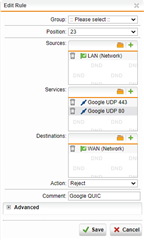Hello everybody,
I watch some incomprehensible things.
On some PCs (home PCs) www.googleadservices.com Pages that pass through my proxy (should be blocked) when using Google Chrome. issuing CA is from google.
When using FireFox the page is blocked and i see my Proxy-CA as issuing CA.
I can't see a single line from the passed googleadservices traffic in the proxy log.
This not occur, if i use my corporate device with google chrome.
Is there a new way to pass proxy or simple an encryption where SG is unable to decrypt?
This thread was automatically locked due to age.


